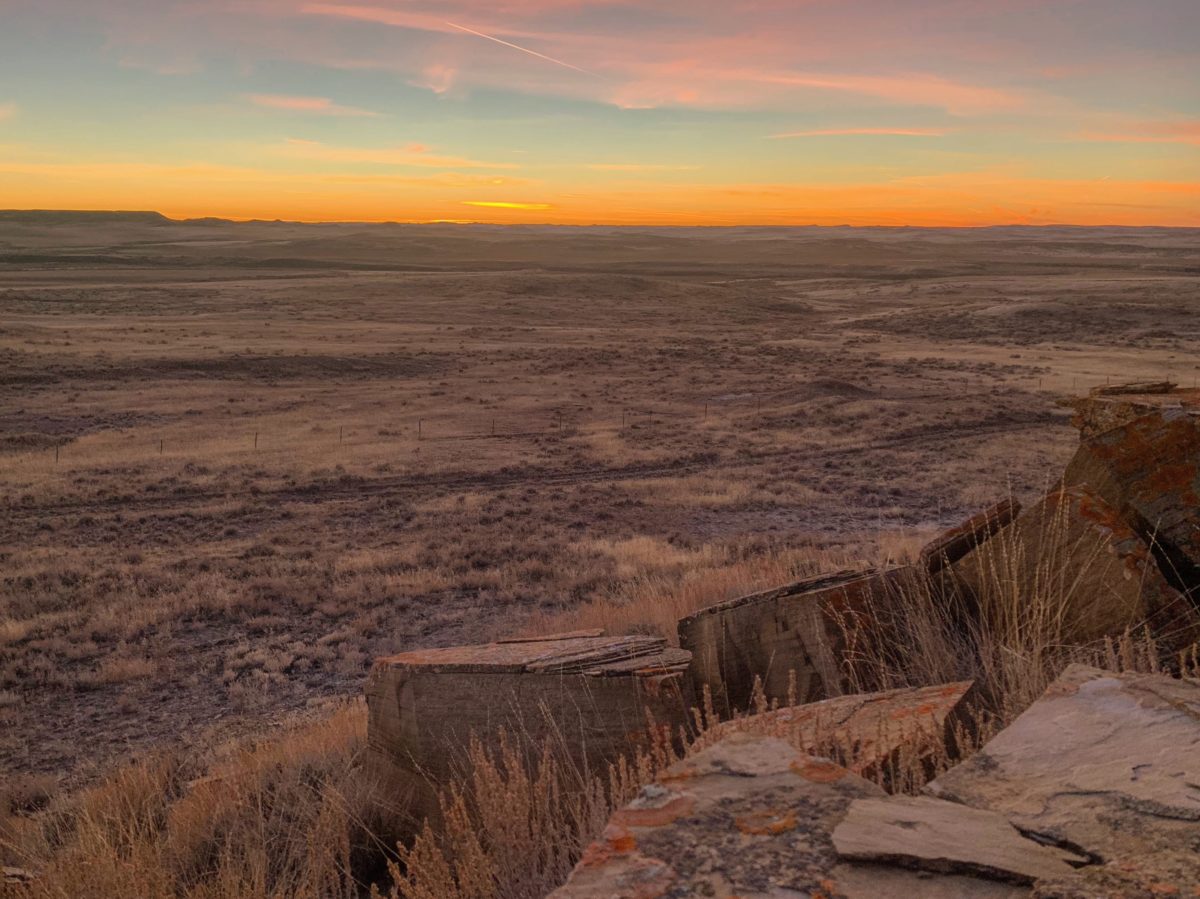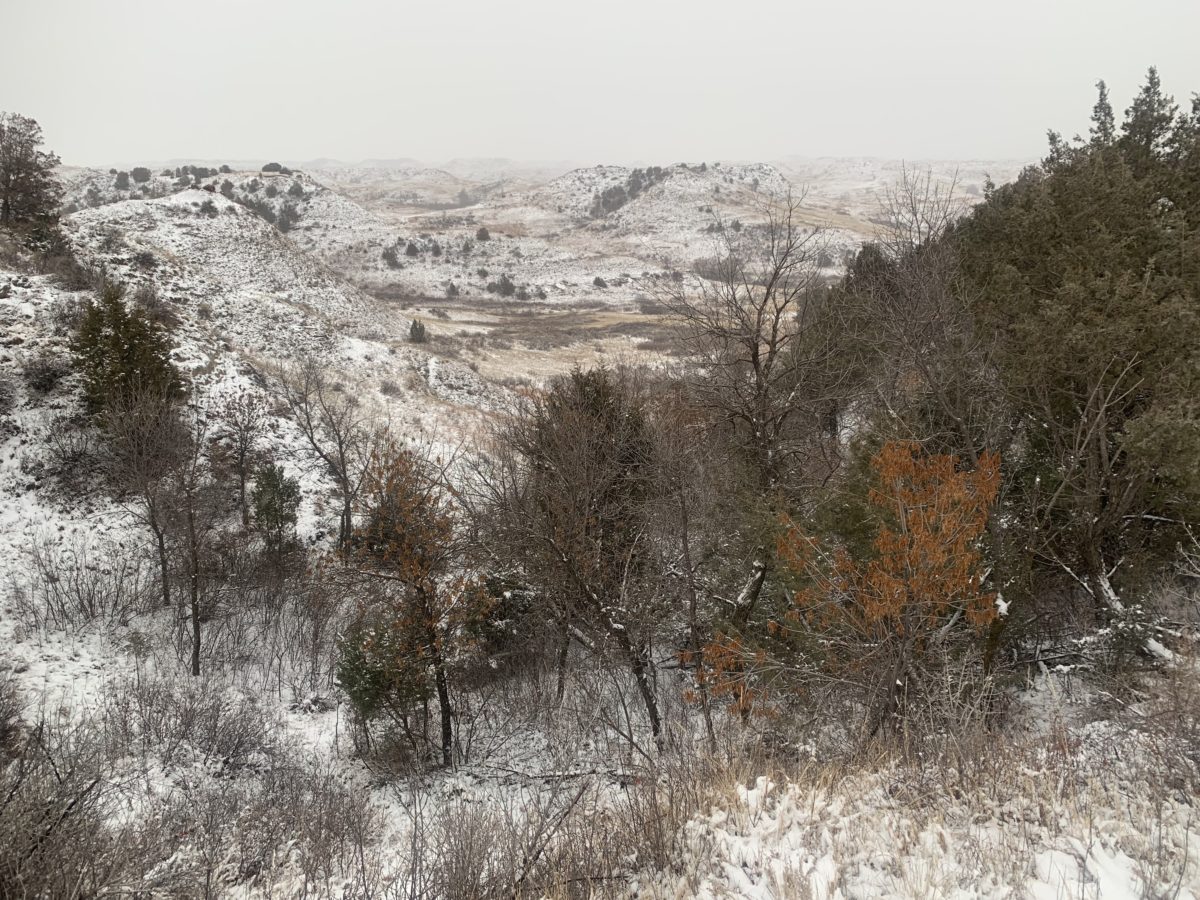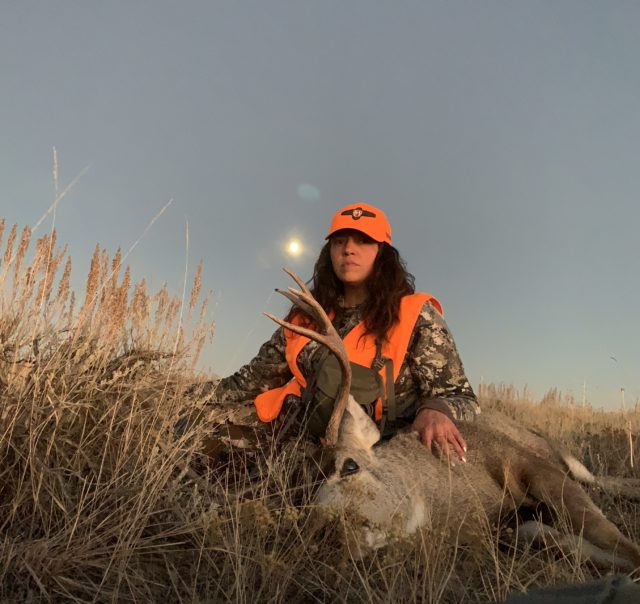qualtieri-header
Do you have any thoughts on this post?
A visit to Theodore Roosevelt’s ranch in the Fall of 2018 inspires a young mule deer hunter
Hunting season is here in my home state of Montana, and I’m headed east to look for mule deer. My dog in the backseat, my Weatherby .308 in its case, and my pack at the ready.
Opening the atlas for a quick survey of my route, a splash of green against the white only a few hundred miles ahead grabs me. Theodore Roosevelt National Park beckons from just over the North Dakota state line, right on the edge of the map. I decide hunting can wait for an afternoon. History calls.
The further east I get, the more the flat dreariness of winter-come-early sets in. The clear, dry roads become two lines edged in white, and the moody sky envelops much of the distant horizon. I’m one of only two cars when I roll into the parking lot at the visitor’s center.

The park sits on 70,446 acres that include parcels from Roosevelt’s original cattle ranches. And although the name itself has gone through a few iterations, no national park is more closely associated with a single individual.
Cottonwoods and red willows follow the Little Missouri River’s snaking path through the otherwise broken, sage-brushed landscape. Weather shrouds the tumbling edges of the park, clouds hugging the muted tones of this northern ground.
On display at the park’s headquarters are belongings and words from our twenty-sixth president. For the most part, they illuminate the mundane aspects of his life rather than the mythical. His cabin is preserved on ground, small and humble. There’s a note written to his brother. Photographs of T.R. and his friends. And a full tribute to his passion for birding, including a snowy owl he taxidermied himself. His essence fills the room. He becomes human here.
But it’s the bullet-holed shirt in the glass case that catches my imagination.
You likely know the story: In the course of Roosevelt’s failed bid for the presidency in 1912, a would-be assassin shot him before a scheduled address in Milwaukee. Fifty pages of notes stuffed into the candidate’s breast pocket slowed the bullet before it entered his chest, where it would stay for the rest of his life. Still, Roosevelt took the stage. Announcing that he had just been shot, he quipped that he probably wouldn’t talk long. He then carried on for 84 minutes.
This is a man who knew how to create a mythology.
In contrast to the ethereal nature of the Roosevelt lore is the tangibility of the public land beneath my boots, land that once held the footprints of the man himself. It stands as a powerful totem for the miles upon miles of public land that I’ve taken in as a hiker, backpacker, hunter, and angler. The reality of it makes its way into words as I continue into the park itself: T.R.’s life molded stories that still resonate in our cultural memory, but he also created a physical continuity of place for those, as he famously declared, still in the “womb of time.”
This is the same land where Roosevelt grieved the deaths of his mother and his wife, who both passed on the same day in 1884. In his mourning, he found solace among this wild and broken country. He then saw his own sense of loss reflected in the waning numbers of bison and other wildlife vanishing from the plains. With the strength he drew from the land, he derived a sense of purpose infused with hope.
This land beneath my boots became the fertile ground for the seeds of a national conservation ethic.

Back into the cold, with daylight quickly fading. Small snow flurries land on my eyelashes and shoulders. In the distance my searching eyes catch three big bull elk, animals reintroduced to this country, now thriving. The humped silhouettes of Roosevelt’s beloved bison graze on far hills. A bounding whitetail deer disappears into the cottonwoods, white flag waving. And then I pull around a corner to face a tank of a mule deer buck walking the edge of the road.
His head is low to the ground, and his behavior is strange. As the car moves closer, another set of tines below him grows visible. I can hear the deer grunting at each other. The smaller buck pins his ears and averts his gaze, submissive. The big guy drops down the hill, circling around until they’re head on. Antlers lock for one moment. Then, the bucks crash into each other with every amount of muscle in their powerful bodies. Pummeled backwards through the sage, the little buck is outmatched. He escapes with a poke in the butt and a chase along the hilly horizon.
The drama of this high-stakes encounter seems befitting of this place—T.R. himself was fond of an old-fashioned test of wills—and all the more-so because the mule deer so perfectly embodies the sagebrush country that shaped Roosevelt’s life.
It’s also a reminder that the rut is on and I’m planning to hunt in the morning, so I best get back on the road.
To public land I go.
The days that follow take me to a wilderness study area, BLM land, and a national wildlife refuge. Each step in the rugged breaks country is another gift from Roosevelt’s generous legacy. I barely see a thing before spotting my buck from over a mile away on Montana state land.
I walk that mile through the sagebrush slowly and intentionally. I set up within a hundred yards, prone in the cold, wet dirt. I have the wind. And I study him thoroughly. He’s everything I love in a mule deer. Thick-bodied, wildly unibrowed, and handsome. Crowned like a king.
There are only a few days left in the season, and I promised myself I’d take the first ethical shot on an animal that presented the opportunity. I wait for what seems like an eternity for him to turn broadside, but in my heart I’m telling him to run and to run far and fast. With five minutes of shooting light to spare, he steps to the side. My heart isn’t ready, but the hunter within flips to fire and pulls the trigger. The hit is solid, well-placed. I chamber another round, but there’s no need. I put down my rifle, my heart breaks, I cradle my head in my hands.

Later, kneeling beside him, I notch the date into my tag: November 20, 2018. I roll the tag, tape it onto his leg, and begin to quarter him out.
Roosevelt’s glorious heritage is now mine to hold. I take it all in. My mule deer’s coat is thick, healthy, buoyant to the touch. He smells deeply sweet, a concentrated musk of sage and this arid earth beneath us. He made a life on habitat protected for his sake. The ground that sustained him will soon sustain me.
“I do not believe that any man can adequately appreciate the world of today unless he has some knowledge of—a little more than a slight knowledge, some feeling for and of—the history of the world of the past,” Roosevelt said.
And this knowledge is what brings me out of my initial grief and back to the sinew and muscle in front of me, to the sky going navy above me, and to the sagebrush sea before me. This is what brings me back to the privilege of being here—two hands on a deer and two feet on public ground.
The passage of time has seen the roots of our public lands heritage grow deeper. Roosevelt’s country has no doubt changed over the years, yet it remains intact. Still, the conservation ethic that he upheld and turned into a physical reality for all Americans remains imperiled to this day. It, too, takes a bullet in the chest and stands tall, time and time again.
As I quarter my deer, slowly, deliberately, I know that the great central task of upholding this public land inheritance and passing it along to those who come after me is a hell of a thing to take on. The weight of this uncertain future is heavy, and it rests on the shoulders of anyone who seeks to leave this place better than we found it.
I finish quartering my deer and fill my pack to overflowing. I tighten the straps on my shoulders, braced for the work ahead.
Nicole Qualtieri is the hunting and fishing editor for GearJunkie.com and a freelance creative. She’s an outdoorswoman, a public lands advocate, and an amateur gourmand. When the weather warms up, you’ll find her astride her little brown horse with a border collie in tow, high in the Montana hills.
President and CEO of the Theodore Roosevelt Conservation Partnership Whit Fosburgh issued the following statement upon the nomination of Mr. David Bernhardt to serve as Interior Secretary:
“No issue is more important to America’s hunters and anglers than the management of the nation’s public lands. David Bernhardt’s return to the Department in 2018 brought a wealth of legal and policy knowledge to the Department’s senior executive team.
The Theodore Roosevelt Conservation Partnership has worked closely with Mr. Bernhardt in his roles as Deputy Secretary and Acting Secretary, and we have found him to be accessible, fair, and true to his word. He has been a steady hand during challenging times at the Department and he has worked to strengthen relationships with the states and the nation’s sportsmen and women.
Mr. Bernhardt’s nomination to be Secretary of the Interior places him in an unenviable position to balance the priorities of the Trump Administration with the mission of the Department. We have often disagreed on policies, such as the pace and siting of energy development and the failure of the department to require developers to mitigate the damage they do to the lands that belong to all Americans. At the same time we have worked productively with Mr. Bernhardt to expand recreational access to public lands and protect big game migration corridors.
We believe Mr. Bernhardt cares about the Department, and in his work with the TRCP, Mr. Bernhardt has conveyed his commitment to advance the Department’s mission and support its role as steward for the public lands and natural resources that help make America unique.
We support Mr. Bernhardt’s nomination for Secretary of the Interior to advance pragmatic conservation, and we pledge to hold him accountable to the sportsmen and women we represent.”
Photo courtesy of Zion National Park.
U.S. Representatives Ralph Abraham and Marc Veasey introduce bill in new Congress to help protect hunting economy.
U.S. Representatives Ralph Abraham (R-La.) and Marc Veasey (D-Texas) are introducing legislation to help combat the spread of chronic wasting disease among deer, elk, and moose populations across the United States.
The bill directs the U.S. Departments of Agriculture and Interior to study how chronic wasting disease (CWD) is transmitted, how quickly it spreads among a given population, and how easily it infects individual animals. With CWD now present in 26 states, this legislation will provide critical information to guide future wildlife management decisions.
“Chronic wasting disease threatens America’s hunting tradition and our nation’s model for funding conservation,” says Whit Fosburgh, president and CEO of the Theodore Roosevelt Conservation Partnership. “This legislation will provide solid scientific data so we can attack this disease head-on and protect deer herds across our nation. We want to thank Representatives Abraham and Veasey for their leadership and look forward to advancing this bill in the new Congress.”
In 2018, TRCP and National Deer Alliance rallied more than 1,000 hunters to call both for updates to the U.S. Department of Agriculture’s standards for responding to CWD outbreaks in captive herds and for the Department to take meaningful steps to curb the spread of the disease. The TRCP also joined 29 conservation groups in asking Agriculture Secretary Sonny Perdue to allow the hunting public more time to comment on its proposed CWD program standards.
Companion legislation is expected to be introduced in the Senate in the coming weeks.
Photo courtesy of Bill Sincavage.
TRCP leads effort to support permanent reauthorization of the Land and Water Conservation Fund.
The Theodore Roosevelt Conservation Partnership and 42 other organizations are urging Senate leadership to immediately vote on a bipartisan agreement to permanently reauthorize the Land and Water Conservation Fund and improve outdoor recreation opportunities.
The group of hunting, fishing, wildlife conservation, and outdoor recreation organizations points to the overwhelmingly bipartisan support for this historic public lands legislation (S.47) in both the House and Senate.
“The momentum and support for this package remains widespread across a variety of public lands stakeholders, and urgent consideration of the package in the new Congress is well warranted,” the organizations wrote. “It is thoroughly bipartisan in nature and broad in scope, and passage of this package would be a historical step forward for public lands and conservation.”
U.S. Senators Lisa Murkowski (R-Alaska) and Maria Cantwell (D-Wash.) negotiated the legislation last Congress and received a commitment to bring the bill to the Senate floor for a vote in the 116th Congress.
The group notes passage of this bill is critical, “so that future generations of Americans can enjoy our public lands, waterways, and the wildlife that inhabit them for years to come.”
The group’s letter is available HERE.
Photo courtesy of BLM and Bob Wick.
Theodore Roosevelt’s experiences hunting and fishing certainly fueled his passion for conservation, but it seems that a passion for coffee may have powered his mornings. In fact, Roosevelt’s son once said that his father’s coffee cup was “more in the nature of a bathtub.” TRCP has partnered with Afuera Coffee Co. to bring together his two loves: a strong morning brew and a dedication to conservation. With your purchase, you’ll not only enjoy waking up to the rich aroma of this bolder roast—you’ll be supporting the important work of preserving hunting and fishing opportunities for all.
$4 from each bag is donated to the TRCP, to help continue their efforts of safeguarding critical habitats, productive hunting grounds, and favorite fishing holes for future generations.
Learn More
